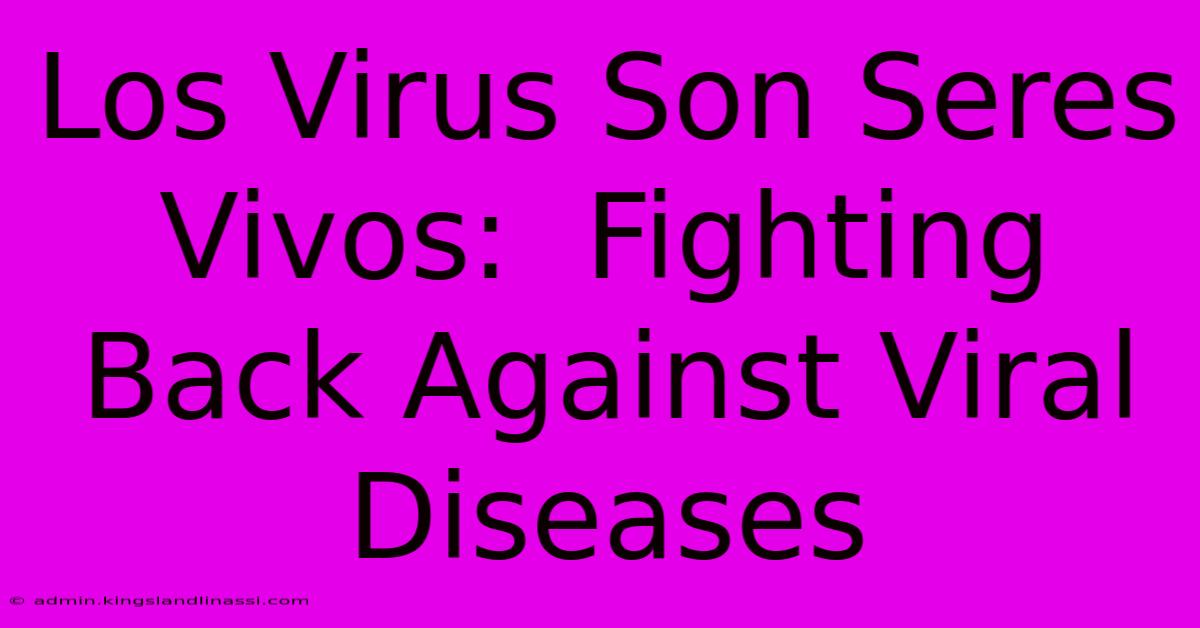Los Virus Son Seres Vivos: Fighting Back Against Viral Diseases

Table of Contents
Los Virus Son Seres Vivos: Fighting Back Against Viral Diseases
The question of whether viruses are truly alive is a complex one, sparking debate among scientists. While they lack the cellular structure and independent metabolic processes of living organisms, their ability to replicate and evolve makes them potent agents of disease. Understanding this nuanced reality is crucial in our fight against viral illnesses. This article explores the nature of viruses, their impact on human health, and the strategies we employ to combat them.
¿Qué son los virus? Understanding the Nature of Viruses
Unlike bacteria, which are self-sufficient cells, viruses are essentially genetic material (DNA or RNA) encased in a protein coat. They are obligate intracellular parasites, meaning they require a host cell to replicate. They hijack the host cell's machinery, forcing it to produce more viruses, ultimately leading to cell damage or death. This parasitic nature is a key factor in their pathogenicity. Los virus no pueden reproducirse por sí mismos; necesitan una célula huésped.
Characteristics of Viruses:
- Acelular: They lack a cellular structure.
- Parásitos obligados: They depend entirely on a host cell for replication.
- Genomas simples: Their genetic material is relatively simple compared to cells.
- Alta tasa de mutación: This contributes to their ability to evade the immune system and develop drug resistance.
- Diversidad amplia: Viruses infect a vast range of organisms, from bacteria to humans.
El impacto de las enfermedades virales: The Impact of Viral Diseases
Viral diseases pose a significant threat to global health. They range from relatively mild infections like the common cold to severe and potentially fatal illnesses such as influenza, HIV, and Ebola. The impact of these diseases extends beyond individual suffering to include economic burdens, healthcare strain, and societal disruption.
Examples of Viral Diseases and Their Effects:
- Influenza (Gripe): Causes respiratory illness, potentially leading to severe complications in vulnerable populations.
- VIH/SIDA: A chronic and potentially fatal disease that weakens the immune system.
- COVID-19: A highly contagious respiratory illness that has caused a global pandemic.
- Sarampión (Measles): A highly contagious disease that can lead to serious complications.
- Hepatitis: Inflammation of the liver, with various types caused by different viruses.
Combatir las enfermedades virales: Fighting Viral Diseases
Combating viral diseases requires a multi-pronged approach, encompassing prevention, treatment, and research.
Preventive Measures:
- Vacunación: Vaccination is a highly effective way to prevent many viral infections. Vaccines stimulate the immune system to produce antibodies against specific viruses.
- Higiene: Practicing good hygiene, such as frequent handwashing and covering coughs and sneezes, can help prevent the spread of viruses.
- Medidas de control de infecciones: Implementing infection control measures in healthcare settings is crucial to limiting the spread of viral diseases.
Tratamientos:
- Antivirales: Antiviral medications can help reduce the severity and duration of some viral infections. However, they are not always effective against all viruses, and some viruses develop resistance to these drugs.
- Terapias de apoyo: Supportive care, such as rest, fluids, and pain relief, is often crucial in managing viral illnesses.
Investigación: The Importance of Research
Ongoing research is essential to developing new and improved vaccines, antiviral drugs, and diagnostic tools. Research into the mechanisms of viral replication and immune evasion is crucial for developing effective therapeutic strategies. Understanding the evolutionary dynamics of viruses is critical for predicting and responding to emerging infectious diseases.
Conclusión:
While the classification of viruses as "living" remains debated, their impact on human health is undeniable. A comprehensive understanding of viral biology, coupled with robust prevention and treatment strategies, is crucial in mitigating the global burden of viral diseases. Continuous research and global cooperation are essential in the ongoing fight against these potent pathogens. The future of public health relies on our ability to anticipate, adapt, and effectively combat evolving viral threats.

Thank you for visiting our website wich cover about Los Virus Son Seres Vivos: Fighting Back Against Viral Diseases. We hope the information provided has been useful to you. Feel free to contact us if you have any questions or need further assistance. See you next time and dont miss to bookmark.
Featured Posts
-
Age Of Empires 3 Hile The Complete Beginners Guide
Apr 28, 2025
-
Lady Gaga S Net Worth Building A Lasting Fortune
Apr 28, 2025
-
Sophie Rains Age And The Years To Come
Apr 28, 2025
-
Surviving The Unthinkable A Doomsday Moms Story
Apr 28, 2025
-
Raquel Welchs Daughter Living Life To The Fullest
Apr 28, 2025
